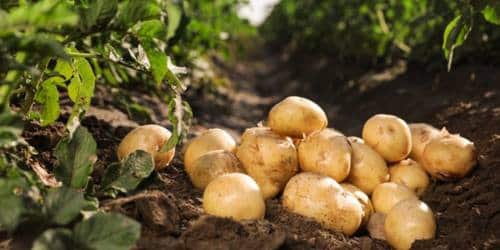Potatoes are a primary food crop that is widely grown in Nigeria and throughout Africa. Millions of farmers in the region have the potential to benefit from potato farming in terms of food security, revenue generation, and employment creation. Nigeria, behind Egypt and Ethiopia, is the third greatest producer of potatoes in Africa, according to statistics. In this article, you will learn everything you need to know about potato farming which can also apply to sweet or Irish potatoes, the equipment used in farming, and how to start the farming process.
What Is A Potato?
The potato (Solanum tuberosum) is a starchy root vegetable that is a key staple crop around the world. It belongs to the nightshade family, Solanaceae. Potatoes are farmed for their edible tubers, which can be found in a variety of colors, shapes, and sizes. They are high in carbs, vitamins, and minerals and are used in a variety of cuisines. Potato farming is a common agricultural technique in Nigeria and Africa, with an increasing demand for the crop due to its culinary diversity and nutritional value.
What Is Potato Farming In Nigeria?
Potato farming is the production of potatoes, which are starchy root crops farmed and consumed all over the world. In order to provide for the needs of both the farmer and the consumer, the government has mandated that all agricultural activities be conducted in accordance with the law. Potatoes are used in a range of meals such as chips, fries, and mashed potatoes, as well as potato flour and potato starch.
Potato farming necessitates careful preparation of the soil, planting, irrigation, and insect control. Potatoes are used to make industrial starch, alcohol, and animal feed in addition to being an important food crop.
Types Of Potatoes Used For Potato Farming In Nigeria
In Nigeria and Africa, many types of potatoes are utilized for potato farming. They are as follows:
#1. Irish potato
This is the most common potato variety grown in Nigeria and Africa, and it can also be used in farming. It is high in vitamins and minerals and is in high demand in both domestic and international markets.
#2. Sweet potato.
These potato tubers are really sweet and delicious! This potato’s incredible sweetness is frequently available in two varieties. Red sweet potatoes with pointy tips feature reddish-brown skin and sweet, moist orange flesh.
The Cuban, white, or bonito sweet potato has pale tan skin and yellow, more dry flesh. Both can be roasted, steamed, baked, boiled, mashed, or pureed and are used in desserts such as pies, muffins, and bread. It can even be spiralized to create noodles. If you thoroughly clean and dry the thick skins, you can roast them for a crispy delight that is also high in fiber and nutrients.
Yams are less sweet than sweet potatoes. They can have white to deep red flesh and can be substituted for sweet potatoes depending on the application.
#3. White Potato
These round or oblong-shaped potatoes have thin golden-colored skin and waxy meat that is yellow or sometimes pale in hue. This potato is also known as an all-purpose potato and is available in White Rose or Finnish yellow variants. They can be steamed, boiled, roasted, or sautéed.
Yukon Gold is another white potato variety/type that is spherical, medium-sized and has a thin, soft pale yellow skin. They are popular because of their creamy golden flesh with a buttery flavor. They can be cooked by boiling, baking, roasting, or frying.
#4. Red Potato
When cooked, the white and waxy flesh of these roundish, tiny, and reddish thin-skinned potatoes becomes creamy. They are available in Red Bliss, Norland, and Red Pontiac types. They’re great for crispy roasted potatoes, as well as boiled, steamed, or simmering soups and stews.
#5. Purple potato
These regal-looking Spuds feature thin deep purple skin and vivid purple, solid, and starchy meat with an earthy and slightly nutty flavor. Cooking darkens the skin while somewhat lightening the flesh. They can be roasted, boiled, steamed, or simmered. Purple potatoes that are larger in size are ideal for baking and mild mashing.
The added antioxidants from anthocyanins in the purple flesh and skin for more plant nutrients make this potato unique! Purple Majesty, Purple Peruvian, All Blue, and Purple Viking are just a handful of the colors available.
Benefits of Potato Farming In Nigeria
Some advantages of engaging in potato farming in Nigeria, whether sweet or Irish potato, include:
- Nutritious: Potatoes are a good source of vitamins and minerals, making them a healthy meal choice.
- Employment: Potato farming can give people employment options, thereby helping to lower unemployment rates in Nigeria and Africa.
- Income: Potato farming may be a profitable business enterprise, providing farmers and their families with a source of money.
- Food security: Potato farming, as an essential staple crop, can contribute to food security in Nigeria and Africa.
- Drought-resistant: Potatoes can endure drought conditions, making them a viable crop in places with minimal rainfall.
- High yield: Potato plants produce a high production of potatoes per unit of area, making it an efficient crop.
- Versatile: Potatoes are a versatile crop that can be used for a variety of purposes, including food, livestock feed, and the production of industrial starch and alcohol.
- Rotational crop: Potatoes are an excellent rotational crop, improving soil fertility and reducing soil-borne illnesses.
How To Start Potato Farming In Nigeria
Here’s a step-by-step guide to getting started in potato farming in Nigeria and Africa:
#1. Land Preparation
Plow the land to loosen it up and allow for aeration and water penetration. To reduce the effect of the medications, use glyphosate with paraquat on the land and wait two weeks before planting. Create good ridges or beds for planting; grow potatoes on the bed for proper tuberization. Allow 1m between the field and any adjacent farmland to prevent rodents from eating the tubers.
It may grow in a variety of soil types, but sandy loam soil rich in organic matter produces the best results. If the land lacks nutrients, you might add manure when preparing it. A PH of 5.5-6.5 is optimal for growth.
#2. Planting
Potatoes are grown from stem and vine cuttings taken from the parent plant. The vine cutting should be 20-30cm long, with roughly 2-3 nodes per vine. Sow the vine 4-6cm deep in the soil, leaving a portion of it above ground. On ridges, space them 25-30cm apart; 60-75cm apart. You can plant up to 27,000-50,000 vine cuttings per hectare, depending on the spacing distance. In an acre, there are 11,000 vine cuttings.
#3. Weeding/Fertilization
Weeding should be done as soon as possible after planting to ensure that the potato young plants have no competition, perhaps 2 weeks after planting and then again 2 weeks later. However, because the plant crawls and covers the earth, the weed will be unable to germinate.
Potato farming can be done entirely with organic manure; but, if chemical fertilizer is required, utilize NPK 10:10:20.
#4. Irrigation/Mulching
After germination, mulch the young plant to conserve moisture and allow for optimal root growth.
It can endure drought for a short period of time, but if it lasts longer than 6 weeks, the yield will suffer.
#5. Varieties
Sweet potatoes come in a range of colors, including brownish-yellow, reddish-purple, and pale. They also differ in leaf shape, maturity period, root depth, and disease resistance. Hybrid sweet potatoes are resistant to pests and diseases, have a high yield, and mature early.
#6. Pest/Disease Control
Weevils are the most common insect that attacks sweet potatoes; while the adult feeds on the leaves and stems, causing the vines to thicken and crack, the larva bores into the store roots, generating a bitter substance.
Aphids and white flies (viral illness) induce dwarfing, yellowing of young vine leaves, and over-branching.
#7. Harvest/Yield
Potatoes mature in 3-4 months; the white variety matures in 3 months. The popular variety matures in four months. When the leaves of the sweet potato turn yellow, it is time to harvest. Dig the tubers out of the dirt with a shovel, hand fork, and pick axe, being cautious not to harm them because they won’t last long.
#8. Storage
After collecting potatoes, allow them to cure for about 2 weeks before keeping them in a cool, dry place. However, it should not be too long to avoid tying up your money unnecessarily.
#9. Marketing
Sell to market dealers who are anticipating the arrival of the potatoes. Others include livestock breeders, flour millers, and food manufacturers. You can add value to it by establishing your own flour mill company and turning the potatoes into powder. It will earn you more money than selling the entire thing.
Types Of Equipment & Tools Used In The Potato Farming Business In Nigeria
In either sweet or Irish potato farming, the following equipment can be used to process and package potatoes in Nigeria and Africa:
- Potato Washers: Potato washing machines are used to clean and wash potatoes, removing any dirt or debris that may be present on the surface.
- Potato Peelers: Potato peelers are used to remove the skin from potatoes. They are classified into three types: manual peelers, electric peelers, and automatic peelers.
- Potato Cutters: Potato cutters are tools used to shape and size potatoes. They are available in a variety of forms and sizes, including hand-held cutters, electric cutters, and automated cutters.
- Potato Fryers: Potato fryers are machines that cook potatoes. They are classified into three types: electric fryers, gas fryers, and deep fryers.
- Potato Packaging Machines: These machines are used to package potatoes. They are classified as manual packaging machines, automatic packaging machines, or semi-automatic packaging machines.
While farming, each of these pieces of equipment serves a crucial function in processing and packing either Irish or sweet potato. They contribute to the process’s efficiency and ensure the final product’s high quality.
Why You Should Start Sweet Potato Farming
The following are some of the reasons why you should pay attention to either Irish or sweet potato:
- Potatoes are a low-risk crop.
- More than 100 tubers can be obtained from a single stand.
- It is not expensive to establish a potato plantation.
- Because it is a creeping crop, it is very easy to handle and will limit weed development.
- Potato farming in sacks and containers is possible.
- They mature quickly (3-4 months), allowing you to lease land for potato production if you don’t already have one.
- Extremely profitable
How Long Do Potatoes Take to Grow?
Small young potatoes can be harvested as soon as ten weeks. Full-sized potatoes, on the other hand, require roughly 80-100 days to mature.
Which Month is the Best to Plant Potatoes in Nigeria?
The main planting season for potatoes in Nigeria is between May and August, with the harvest season falling between October and November. However, in some areas, particularly in irrigated areas, potatoes can be grown throughout the dry season.
Is Potato Farming Profitable in Nigeria?
Despite Nigeria’s excellent climate for the development of the cash crop, people have yet to discover the possibilities of the potato business. This demonstrates that people are passing up opportunities to greatly increase their income and even become wealthy through the staple crop.
How Many Potatoes Do You Get Per Plant?
How many potatoes can one plant yield? varying potato types will provide varying yields when harvested. In general, if the plant is healthy, you should be able to pull up approximately five or six full-size potatoes. Every potato plant will very certainly have a slew of smaller, baby-size potatoes.
How Fast Do Potatoes Reproduce?
Growing potatoes typically takes 3-4 months. New potatoes are typically ready 8 weeks, or 60 days/2 months after sowing. Most typical varieties of full-sized potatoes mature in 3 months (90 days), however, some specialty types and larger potatoes can require 4 months (120 days).
To Sum It Up
Finally, potato farming represents a significant possibility for long-term agricultural expansion and economic development in Nigeria and Africa. The potato is a valuable and marketable product because it is a highly nutritious, diverse, and versatile food crop.
Despite the difficulties associated with potato farming in Nigeria and Africa, such as disease, pests, and restricted access to inputs and markets, there are significant advantages, including greater food security, income generation, and job development.
Related Articles
- POTATO CHIP BRANDS: 2023 List of the Oldest Potato Chip Brands (Updated)
- VEGAN CHEESE BRANDS: Best 10+ Non-Diary Options and Reviews
- Banana Farming in Nigeria: Everything You Need To Know
- Best Online Business Ideas to Try Out in Nigeria 2023
- Chip Brands: 2023 Top Most Popular 21 Brands (Updated)






